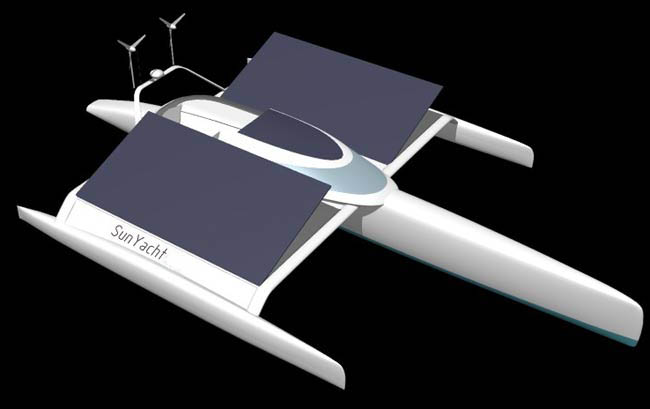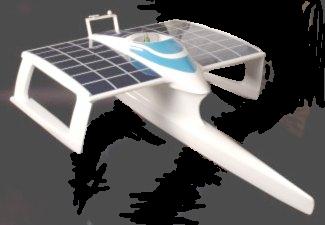|
JULES VERNE TROPHÉE
SAILING YACHTS CIRCUMNAVIGATION RECORDS
Please use our A-Z INDEX to navigate this site or return HOME
|
|||||||||||||||||||||||||||||||||||||||||||||||||||||||||||||||||||||||||||||||||||||||||||||||||||||||||||
|
Around the World in Eighty Days (French: Le tour du monde en quatre-vingt jours) is a classic adventure novel by Jules Verne, first published in 1872. In the story, Phileas Fogg of London and his newly employed French butler Passepartout attempt to circumnavigate the late Victorian world in 80 days on a £20,000 wager set by his friends at the Reform Club. The technological innovations of the 19th century had opened the possibility of rapid circumnavigation and the prospect fascinated Verne and his readership. The book may have been inspired by the exploits of George Francis Train, who accomplished the feat in 1870.
Plot summary
Spoiler warning: Plot or ending details follow.
The story starts in London on October 2, 1872. Phileas Fogg is a wealthy, solitary, unmarried man with regular habits. The source of his wealth is not known and he lives modestly. He fires his former butler, James Forster, for bringing him his shaving water two degrees too cold. He hires as a replacement Passepartout, a Frenchman of around 30 years of age.
Later that day in the Reform Club, he gets involved in an argument over an article in The Daily Telegraph, stating that with the opening of a new railway section in India, it is now possible to travel around the world in 80 days.
The schedule is given as follows:
Fogg accepts a wager for 20,000 pounds from his fellow club members, which he will receive if he makes it around the world in 80 days. He sets off immediately, taking his puzzled new butler with him. He leaves London by train at 8.45 p.m. on October 2, and thus is due back at the Reform Club at the same time 80 days later, on December 21.
Fogg and Passepartout reach Suez in time. While disembarking in Egypt, he is watched by a Scotland Yard detective named Fix, who has been dispatched from London in search of a bank robber. Because Fogg matches the description of the bank robber, Fix mistakes Fogg to be the criminal. Since he cannot secure a warrant in time, Fix goes on board of the steamer conveying the travelers to Bombay. During the voyage, Fix gets acquainted with Passepartout, without revealing his purpose.
Still in time, Fogg and Passepartout switch to the railway in Bombay, setting off for Calcutta, Fix now following them undercover. As it turns out, the construction of the railway is not totally finished, so they are forced to get over the remaining gap between two stations by riding an elephant, which Phileas Fogg purchases at the prodigious price of 2,000 pounds.
During the ride, they come across a suttee procession, in which a young Indian woman, Aouda, is led to a sanctuary to be sacrificed the next day. Since the young woman is obviously drugged and not going voluntarily, the travelers decide to rescue her. They follow the procession to the site, where Passepartout secretly takes the place of the girl's deceased husband on the funeral pyre, on which the woman is going to be burned the next morning. During the ceremony, he then rises from the pyre, scaring off the priests, and carries the young woman away.
The travelers then hasten on to catch the train at the next railway station, taking the girl, Aouda, with them. At Calcutta, they finally board a steamer going to Hong Kong. Fix, who had secretly been following them, again failed to obtain a warrant against Fogg in Calcutta and is forced to follow them along to Hong Kong. On board, he shows himself to Passepartout, who is delighted to meet again his traveling companion from the earlier voyage.
In Hong Kong, it turns out that Aouda's distant relative in whose care they had been planning to leave her there, has moved away, so they decide to take her with them to Europe. Meanwhile, still without a warrant, Fix sees Hong Kong as his last chance to arrest Fogg on British soil. He therefore confides in Passepartout, who does not believe a word and remains convinced that his master is not a bank robber. To prevent Passepartout from informing his master about the premature departure of their next vessel, Fix makes Passepartout drunk and drugs him in an opium den. In his dizziness, Passepartout yet manages to catch the steamer to Yokohama, but neglects to inform Fogg.
Fogg, on the next day, discovers that he has missed his connection. He goes on search for a vessel which will take him to Yokohama. He finds a pilot boat which takes him and his companions (Aouda and Fix) to Shanghai, were they catch a steamer to Yokohama. In Yokohama, they go on a search for Passepartout, believing that he may have arrived there with the original connection. They find him in a circus, trying to earn his homeward journey.
Reunited, the four board on a steamer taking them across the Pacific to San Francisco. Fix promises Passepartout that now, having left British soil, he will no longer try to delay Fogg's journey, but rather support him in getting back to Britain as fast as possible (to have him arrested there).
In San Francisco, they get on the train to New York. During that trip, the train is attacked by Indians, who take Passepartout and two other passengers hostage. Fogg is now faced with the dilemma of continuing his tour, or going to rescue Passepartout. He chooses the latter, starting on a rescue mission with some soldiers of a nearby fort, who succeed in freeing the hostages.
To make up for the lost time, Fogg and his companions hire a sledge, which brings them to Omaha, where they arrive just in time to get on a train to Chicago, and then another to New York. However, reaching New York, they learn that the steamer they had been trying to catch has left a short time before.
On the next day, Fogg starts looking for an alternative for the crossing of the Atlantic. He finds a small steam boat, destined for Bordeaux. However, the captain of the boat refuses to take the company to Liverpool, wherupon Fogg accepts to be brought to Bordeaux. On the voyage, he bribes the crew to mutiny and take course for Liverpool. Going on full steam all the time, the boat runs out of fuel after a few days. Fogg buys the boat at a very high price from the captain, soothing him thereby, and has the crew burn all the wooden parts to keep up the steam.
The companions arrive at Liverpool several hours before the deadline, which would easily suffice to get to London by train. However, once on British soil again, Fix produces a warrant and arrests Fogg. A short time later, the misunderstanding is cleared up - the actual bank robber had been caught several days ago. However, Fogg has missed the train and returns to London 5 minutes late, assured that he has lost the wager.
In his London house the next day, he apologizes to Aouda for bringing her with him, since he now has to live in poverty and cannot financially support her. Aouda suddenly confesses that she loves him and asks him to marry her, which he gladly accepts. He calls for Passepartout to notify the reverend. At the reverend's, Passepartout learns that he is mistaken in the date, which he takes to be Sunday but which actually is Saturday due to the fact that the party traveled in Eastern direction, thereby gaining a full day on a journey around the globe, by crossing the International Date Line.
Passepartout hurries back to Fogg, who immediately sets off for the Reform Club, where he arrives just in time to claim the wager won. Thus ends the journey around the world, which made Phileas Fogg not only a little richer but also the happiest man.
Imitators
Verne's articulation of the challenge proved seminal. There have since been sundry expeditions that emulate Fogg's, fictional, circumnavigation, often within self-imposed constraints.
Film adaptations
The book has been adapted many times for feature films and television.
MODERN TECHNOLOGY RACE - JULES VERNE: WORLD HYDROGEN CHALLENGE
Two European teams are now planning to try and set world navigation records in a solar powered boat. The first team was from the United Kingdom.
The second and latest team to decide to go for it as of March 16 2006, are PlanetSolar, a Swiss/French team is made up of 15 persons, 11 concerned with the boat and expedition directly and 4 on a sponsorship committee - as listed below.
THE BOATS
Though the technology is similar, the designs use quite different approaches. The UK design started out as a SWATH design, first exhibited at Earls Court in 1995. Since that time various wave piercing models have been developed and tested, the aim being to improve performance and reduce build costs. Both teams estimate similar travel times. One day it may be possible to travel around the world on solar power, in under 80 days. Jules Verne would have loved this.
External links
Online versions of the book (http://jv.gilead.org.il/works.html), in French, English, Russian and Dutch. Free eBook of Around the World in Eighty Days (http://www.gutenberg.org/etext/103) at Project Gutenberg Free eBook of Le tour du monde en quatre-vingts jours (http://www.gutenberg.org/etext/3456) at Project Gutenberg (French) Literary analysis of the novels of Jules Verne (http://perso.wanadoo.fr/jules-verne/CIEH.htm) Palin's Travels: Michael Palin's Around the World in 80 Days (http://www.palinstravels.co.uk/static-7) Around the World in 80 Days (http://www.jules-verne.co.uk/around-the-world-in-80-days/) - in easy to read HTML format. Around the World in 80 Days Jr Ed (http://www.jules-verne.co.uk/around-the-world-in-80-days-jr-ed/) Le Tour Du Monde En Quatre Vingts Jours (http://www.jules-verne.co.uk/french-le-tour-du-monde-en-quatre-vingts-jours/) - (French text). De reis om de wereld in tachtig dagen (http://www.jules-verne.co.uk/dutch-de-reis-om-de-wereld-in-tachtig-dagen/) - (Dutch text).
In 1985 a Trophee was proposed for sailing around the world. In 1993 Bruno Peyron accepted the challenge in Commodore Explorer, coming in at 79 days 6 hours and 16 minutes. Since then, the event has seen regular challenges for the trophy - as listed below.
LIST
OF TROPHY HOLDERS:
LIST OF ATTEMPTS:
2021
- Charles
Caudrelier / Gitana Team 1st attempt - Maxi Edmond
de Rothschild & Franck Cammas
CONTACTS
Association
Tour du Monde en 80 Jours Email: contact@tropheejulesverne.org
GENERAL HISTORY LINKS
MARITIME HISTORY
Solar Cola - a healthier alternative to regular colas
LINKS & REFERENCE
https://www.tropheejulesverne.org/en/
|
|||||||||||||||||||||||||||||||||||||||||||||||||||||||||||||||||||||||||||||||||||||||||||||||||||||||||||
|
|
|||||||||||||||||||||||||||||||||||||||||||||||||||||||||||||||||||||||||||||||||||||||||||||||||||||||||||
|
Please use our A-Z INDEX to navigate this site
This website is Copyright © 2021 Cleaner Ocean Foundation Ltd, equal opportunities companies. This website is carbon friendly, using less energy to load on average per page via simplicity & picture optimization. The same may not apply to third party links. 'Jules Verne Hydrogen Trophy' ™is a trademark, the paternal rights asserted by COF Ltd. All rights reserved.
|

